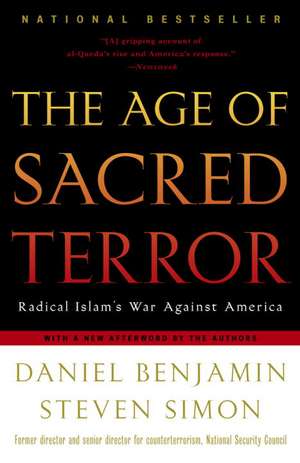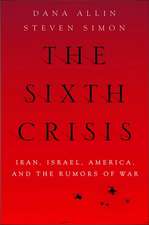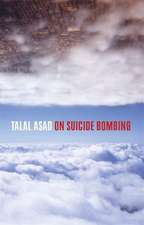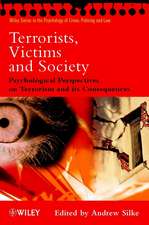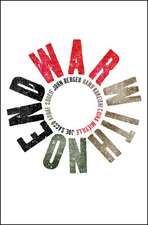The Age of Sacred Terror: Radical Islam's War Against America
Autor Dan Benjamin, Steven Simon, Daniel Benjaminen Limba Engleză Paperback – 30 sep 2003
From two of the world’s foremost experts on the new terrorism comes the definitive book on the rise of al-Qaeda and America’s efforts to combat the most innovative and dangerous terrorist group ever. Daniel Benjamin and Steven Simon trace the growth of radical Islam from its medieval origins and, drawing on their years of counter-terrorism work at the National Security Council, provide essential insights into the thinking of Usama bin Laden and his followers. With unique authority, they analyze why America was unable to defend itself against this revolutionary threat on September 11, 2001, why bin Laden’s apocalyptic creed is gaining ground in the Islamic world, and what the United States must do to stop the new terror.
Preț: 141.10 lei
Nou
Puncte Express: 212
Preț estimativ în valută:
27.02€ • 27.57$ • 22.73£
27.02€ • 27.57$ • 22.73£
Carte disponibilă
Livrare economică 04-18 februarie
Preluare comenzi: 021 569.72.76
Specificații
ISBN-13: 9780812969849
ISBN-10: 0812969847
Pagini: 560
Dimensiuni: 132 x 201 x 28 mm
Greutate: 0.57 kg
Editura: Random House Trade
ISBN-10: 0812969847
Pagini: 560
Dimensiuni: 132 x 201 x 28 mm
Greutate: 0.57 kg
Editura: Random House Trade
Notă biografică
STEVEN SIMON, assistant director and senior fellow for U.S. Security Studies at the International Institute for Strategic Studies, served on the National Security Council staff as director for global issues from 1994 to 1998 and senior director for counterterrorism from 1998 to 1999. Prior to entering the administration, he held several positions at the U.S. Department of State dealing with regional security and nonproliferation. He holds degrees from Harvard, Columbia, and Princeton and was an international-affairs fellow at Oxford University.
DANIEL BENJAMIN, senior fellow at the Center for Strategic and International Studies, served as director for counterterrorism on the National Security Council staff from 1998 to 1999 and as special assistant and foreign-policy speechwriter for President Clinton from 1994 to 1997. Prior to entering the administration, he was Berlin bureau chief for The Wall Street Journal and has been a foreign correspondent for Time. He holds degrees from Harvard and Oxford, where he was a Marshall Scholar.
From the Hardcover edition.
DANIEL BENJAMIN, senior fellow at the Center for Strategic and International Studies, served as director for counterterrorism on the National Security Council staff from 1998 to 1999 and as special assistant and foreign-policy speechwriter for President Clinton from 1994 to 1997. Prior to entering the administration, he was Berlin bureau chief for The Wall Street Journal and has been a foreign correspondent for Time. He holds degrees from Harvard and Oxford, where he was a Marshall Scholar.
From the Hardcover edition.
Extras
CHAPTER 1
DAYBREAK
The first killing of the Terror was carried out by an Egyptian in Manhattan. The weapon was not a Boeing 767 but a chrome-plated .357 Magnum, and the attack happened in the conference room of a midtown hotel. One man was killed; two others were injured. Years would pass before anyone realized that the event was more than the solitary act of a deranged man.
On November 5, 1990, El-Sayyid Nosair rushed toward the podium in the Morgan D Room of the Marriott East Side Hotel. Just to the side of the microphone, Meir Kahane was signing books and greeting members of the audience for the speech he had just finished. As he neared the front of the room, Nosair aimed his gun and fired. The bullet tore into Kahane's neck and exited through his cheek. As blood poured from his mouth, Kahane raised his hands to his head and fell backward. The shooter spun and ran toward the exit, but just before the door, he was grabbed by a seventy-three-year-old man named Irving Franklin. Nosair kept moving and dragged Franklin a couple of yards before shooting him in the leg to get free. He sprinted from the hotel and jumped in a cab, thinking it was the getaway car he had arranged. It wasn't. Nosair jammed the gun into the back of the cabbie's head and screamed at him to drive. But traffic was moving slowly, and when a student who had been at Kahane's lecture and chased after Nosair jumped in front of the cab, the driver slid out the door and took off. Nosair abandoned the car, too, but he ran into the path of a Postal Service policeman. Nosair shot and wounded the officer, who returned fire, dropping the Egyptian with a neck wound.
As he lay bleeding on the sidewalk, El-Sayyid Nosair was sure he had changed the course of history.
He believed this because of his bizarre reading of Israeli politics. Kahane was a Brooklyn rabbi who founded the Jewish Defense League and then immigrated to Israel and established the Kach party, which was banned from his country's parliament in 1988 because of its blatant racism-the group advocated, for example, the expulsion of Arabs from Israel and the Occupied Territories. Yet Nosair was convinced that Kahane was destined to be the leader of the Jewish state and a force in global affairs: "They were preparing him to dominate, to be the prime minister someday," he would later say. "They were preparing him despite their assertion that they reject his agenda and that he is a racist."
A thirty-four-year-old from the northeastern Egyptian city of Port Said, Nosair had moved to the United States in 1981 with a university degree in engineering in hand. He was not a happy immigrant. His sister in Egypt later related that he disliked America, saying, "He didn't like the morality there."1 Nonetheless, he stayed, married an American woman, and moved to New Jersey, bouncing from job to job and winding up as a heating and air-conditioning repairman for the City of New York.
To investigators, he seemed mentally disturbed, and a police official described him as depressed. A month after the shooting, a federal investigator said, "Either the man is a lone nut, or he's a lone nut and someone whispered something in his ear knowing he'd do it. Or there's an enormous international conspiracy."2 Authorities quickly settled on the first hypothesis. Their belief that there was nothing more to the case-and, perhaps, the refusal of Kahane's Orthodox family to allow a full autopsy-helps explain the shoddiness of the case prosecutors put together. At trial, the jury could not be convinced that it was Nosair who shot Kahane. He was convicted on two counts of assault, first-degree coercion (for his treatment of the cabbie), and a weapons charge and packed off to the state prison at Attica.
Nosair may in fact have been a bit unbalanced, but he was no loner. And he had been preparing himself for the killing for many months.
He studied weaponry and tactics using official U.S. Army manuals and other sensitive documents that his friend Ali Mohamed, a sergeant at Fort Bragg, the home of the U.S. Special Operations Command in North Carolina, brought him on weekend visits. Together with several others from the Farouq Mosque on Atlantic Avenue in Brooklyn, where he worshiped, he was working on his marksmanship. In the spring and summer of 1989, the group would meet early in the morning and drive out on the Long Island Expressway to the Calverton Shooting Range on eastern Long Island. Mohammed Salameh was there, as were Nidal Ayyad and Clement Hampton-El, an African American hospital worker who had converted to Islam. Many wore the same T-shirt in black or gray: on the top was printed "Help Each Other in Goodness and Piety," and on the bottom "A Muslim to a Muslim Is a Brick Wall." In the middle was printed "Services Office" along with a map of a country with "Afghanistan" written in the center. Mahmud Abouhalima-Mahmud the Red, as he was called because of his hair-sported a National Rifle Association cap. The group brought with them a small arsenal: rifles, shotguns, 9-mm and .357-caliber handguns, and AK-47 assault weapons. Ali Mohamed gave pointers.
The men were training for jihad, Islamic holy war. In 1989, most of the world understood jihad to mean what was written on the men's T-shirts: Afghanistan, the fight against the Soviet Union. By the time Nosair was visiting the firing range, the Soviet Union had been defeated, though fighting continued against the communist regime in Kabul. But to Nosair and his friends, jihad was more than that. It meant, as he wrote in a notebook, attacking all those "who waged war against Allah and his messenger . . . who should be murdered or crucified or . . . their feet should be cut off on opposite sides or they should be exiled from the land." Killing Kahane, he would later boast, was an act of jihad, one in which "God the almighty enabled his extremely brave people, with his great power to destroy one of the top infidels." So, too, was the attempt he reportedly made on the life of Mikhail Gorbachev: he threw a soda can filled with explosives at the Soviet leader's motorcade in 1990, but it did not detonate. And so was the bombing of a gay bar in Greenwich Village in April of the same year, which injured three people and with which he was later linked.
But Nosair had another, more breathtaking vision of jihad. Written in a notebook of his, it called for the "breaking and destruction of the enemies of Allah. And this is by means of destroying exploding, the structure of their civilized pillars such as the touristic infrastructure which they are proud of and their high world buildings which they are proud of and their statues which they endear and the buildings which gather their head[s,] their leaders, and without any announcement for our responsibility of Muslims for what had been done."
El-Sayyid Nosair inaugurated the age of sacred terror with the assassination of a bit player on the world stage, an act wholly uncharacteristic of everything that would follow. But he wrote down the idea for its defining event, the attacks of September 11 and the destruction of the World Trade Center, no later than 1990. The notion of destroying the Twin Towers was almost certainly not Nosair's; the whole speech in which the passage is found was likely something he copied. The language and the horrific grandeur of the imagery mark it as the idea of a man Nosair telephoned regularly in Egypt to apprise of his group's jihad training, and whom he then helped settle in the United States in 1990: Sheikh Omar Ahmad Abdel Rahman. The Blind Sheikh, as he is also known, a cleric revered among Islamist radicals for providing the religious authorization to assassinate Egyptian president Anwar Sadat, had slipped out of Egypt to Sudan in 1990. There, the consular section of the U.S. embassy mistakenly issued him a visa, even though his name was on a watch list. He arrived in America in July of that year and became the central figure of the burgeoning jihadist set in New York and northern New Jersey.
From the Hardcover edition.
DAYBREAK
The first killing of the Terror was carried out by an Egyptian in Manhattan. The weapon was not a Boeing 767 but a chrome-plated .357 Magnum, and the attack happened in the conference room of a midtown hotel. One man was killed; two others were injured. Years would pass before anyone realized that the event was more than the solitary act of a deranged man.
On November 5, 1990, El-Sayyid Nosair rushed toward the podium in the Morgan D Room of the Marriott East Side Hotel. Just to the side of the microphone, Meir Kahane was signing books and greeting members of the audience for the speech he had just finished. As he neared the front of the room, Nosair aimed his gun and fired. The bullet tore into Kahane's neck and exited through his cheek. As blood poured from his mouth, Kahane raised his hands to his head and fell backward. The shooter spun and ran toward the exit, but just before the door, he was grabbed by a seventy-three-year-old man named Irving Franklin. Nosair kept moving and dragged Franklin a couple of yards before shooting him in the leg to get free. He sprinted from the hotel and jumped in a cab, thinking it was the getaway car he had arranged. It wasn't. Nosair jammed the gun into the back of the cabbie's head and screamed at him to drive. But traffic was moving slowly, and when a student who had been at Kahane's lecture and chased after Nosair jumped in front of the cab, the driver slid out the door and took off. Nosair abandoned the car, too, but he ran into the path of a Postal Service policeman. Nosair shot and wounded the officer, who returned fire, dropping the Egyptian with a neck wound.
As he lay bleeding on the sidewalk, El-Sayyid Nosair was sure he had changed the course of history.
He believed this because of his bizarre reading of Israeli politics. Kahane was a Brooklyn rabbi who founded the Jewish Defense League and then immigrated to Israel and established the Kach party, which was banned from his country's parliament in 1988 because of its blatant racism-the group advocated, for example, the expulsion of Arabs from Israel and the Occupied Territories. Yet Nosair was convinced that Kahane was destined to be the leader of the Jewish state and a force in global affairs: "They were preparing him to dominate, to be the prime minister someday," he would later say. "They were preparing him despite their assertion that they reject his agenda and that he is a racist."
A thirty-four-year-old from the northeastern Egyptian city of Port Said, Nosair had moved to the United States in 1981 with a university degree in engineering in hand. He was not a happy immigrant. His sister in Egypt later related that he disliked America, saying, "He didn't like the morality there."1 Nonetheless, he stayed, married an American woman, and moved to New Jersey, bouncing from job to job and winding up as a heating and air-conditioning repairman for the City of New York.
To investigators, he seemed mentally disturbed, and a police official described him as depressed. A month after the shooting, a federal investigator said, "Either the man is a lone nut, or he's a lone nut and someone whispered something in his ear knowing he'd do it. Or there's an enormous international conspiracy."2 Authorities quickly settled on the first hypothesis. Their belief that there was nothing more to the case-and, perhaps, the refusal of Kahane's Orthodox family to allow a full autopsy-helps explain the shoddiness of the case prosecutors put together. At trial, the jury could not be convinced that it was Nosair who shot Kahane. He was convicted on two counts of assault, first-degree coercion (for his treatment of the cabbie), and a weapons charge and packed off to the state prison at Attica.
Nosair may in fact have been a bit unbalanced, but he was no loner. And he had been preparing himself for the killing for many months.
He studied weaponry and tactics using official U.S. Army manuals and other sensitive documents that his friend Ali Mohamed, a sergeant at Fort Bragg, the home of the U.S. Special Operations Command in North Carolina, brought him on weekend visits. Together with several others from the Farouq Mosque on Atlantic Avenue in Brooklyn, where he worshiped, he was working on his marksmanship. In the spring and summer of 1989, the group would meet early in the morning and drive out on the Long Island Expressway to the Calverton Shooting Range on eastern Long Island. Mohammed Salameh was there, as were Nidal Ayyad and Clement Hampton-El, an African American hospital worker who had converted to Islam. Many wore the same T-shirt in black or gray: on the top was printed "Help Each Other in Goodness and Piety," and on the bottom "A Muslim to a Muslim Is a Brick Wall." In the middle was printed "Services Office" along with a map of a country with "Afghanistan" written in the center. Mahmud Abouhalima-Mahmud the Red, as he was called because of his hair-sported a National Rifle Association cap. The group brought with them a small arsenal: rifles, shotguns, 9-mm and .357-caliber handguns, and AK-47 assault weapons. Ali Mohamed gave pointers.
The men were training for jihad, Islamic holy war. In 1989, most of the world understood jihad to mean what was written on the men's T-shirts: Afghanistan, the fight against the Soviet Union. By the time Nosair was visiting the firing range, the Soviet Union had been defeated, though fighting continued against the communist regime in Kabul. But to Nosair and his friends, jihad was more than that. It meant, as he wrote in a notebook, attacking all those "who waged war against Allah and his messenger . . . who should be murdered or crucified or . . . their feet should be cut off on opposite sides or they should be exiled from the land." Killing Kahane, he would later boast, was an act of jihad, one in which "God the almighty enabled his extremely brave people, with his great power to destroy one of the top infidels." So, too, was the attempt he reportedly made on the life of Mikhail Gorbachev: he threw a soda can filled with explosives at the Soviet leader's motorcade in 1990, but it did not detonate. And so was the bombing of a gay bar in Greenwich Village in April of the same year, which injured three people and with which he was later linked.
But Nosair had another, more breathtaking vision of jihad. Written in a notebook of his, it called for the "breaking and destruction of the enemies of Allah. And this is by means of destroying exploding, the structure of their civilized pillars such as the touristic infrastructure which they are proud of and their high world buildings which they are proud of and their statues which they endear and the buildings which gather their head[s,] their leaders, and without any announcement for our responsibility of Muslims for what had been done."
El-Sayyid Nosair inaugurated the age of sacred terror with the assassination of a bit player on the world stage, an act wholly uncharacteristic of everything that would follow. But he wrote down the idea for its defining event, the attacks of September 11 and the destruction of the World Trade Center, no later than 1990. The notion of destroying the Twin Towers was almost certainly not Nosair's; the whole speech in which the passage is found was likely something he copied. The language and the horrific grandeur of the imagery mark it as the idea of a man Nosair telephoned regularly in Egypt to apprise of his group's jihad training, and whom he then helped settle in the United States in 1990: Sheikh Omar Ahmad Abdel Rahman. The Blind Sheikh, as he is also known, a cleric revered among Islamist radicals for providing the religious authorization to assassinate Egyptian president Anwar Sadat, had slipped out of Egypt to Sudan in 1990. There, the consular section of the U.S. embassy mistakenly issued him a visa, even though his name was on a watch list. He arrived in America in July of that year and became the central figure of the burgeoning jihadist set in New York and northern New Jersey.
From the Hardcover edition.
Recenzii
“A lucid, passionate, shocking account of Islamist terrorism. Anyone interested in how the enemies of the West operate will want to read this book. And even those who are not, should.”
-Ian Buruma
"The Age of Scared Terror provides a staggering account of the origins of al-Qaeda, its motives and its bloody history since the early 1990s. After reading this book no one should be in any doubt that a new and unprecedented form of terrorism dedicated to the mass destruction of human life now exists. The book is also the chilling story of how slow and reluctant the West has been to recognize and counter an enemy whose intentions are more deadly than any it has ever faced before. The events of September 11, 2001, changed the world: Ours has truly become the age of sacred terror. This book explains in great and compelling detail how those events were possible, how they might perhaps have been avoided, and how they could occur again. Everyone should read it - and be warned."
-Anthony Pagden
"Of the many books spawned by September 11, this one is in a class by itself. The authors range widely and authoritatively from history to current events; from fast-paced narrative to sharp, often original analysis; from deep behind enemy lines, where they get into the heads of the enemy, to the Situation Room in the basement of the White House where the American response is formulated (and where the authors logged so many hours themselves). In the phrase that has gained such currency since 9/11, here's a book that truly connects the dots. It does so in a spare, lucid style with flashes of real brilliance and with admirable fairness to all three administrations -- from Bush to Clinton to Bush -- that have grappled with a decade of steadily escalating terrorism."
-Strobe Talbott, former deputy Secretary of State and author of The Russia Hand: A Memoir of Presidential Diplomacy
“With telling detail and crisp prose, Benjamin and Simon’s book may emerge as the best insider account.”—Mark Strauss, The Washington Post
“These authors know firsthand how decisions are made within the White House’s National Security Council, irrespective of the political party in power.... [A] meticulously researched, well-written book.”—Judith Miller, The New York Times
“[The] book’s most important and lasting contribution is its exploration of the relationship between al-Qaeda’s toxic message and the Muslim mainstream. [The authors] examine in considerable detail the gradual evolution of Islamist political thought, describing the timeless influence of Islamic thinkers such as the thirteenth-century theologian Taqi al-Din ibn Taymiyya and the eighteenth-century preacher Muhammad ibn Abd al-Wahhab, whose ideas form the political and religious foundation of modern Saudi Arabia.”—Ellen Laipson, Foreign Affairs
“[A] gripping account of al-Qaeda’s rise and America’s response.”—Newsweek
-Ian Buruma
"The Age of Scared Terror provides a staggering account of the origins of al-Qaeda, its motives and its bloody history since the early 1990s. After reading this book no one should be in any doubt that a new and unprecedented form of terrorism dedicated to the mass destruction of human life now exists. The book is also the chilling story of how slow and reluctant the West has been to recognize and counter an enemy whose intentions are more deadly than any it has ever faced before. The events of September 11, 2001, changed the world: Ours has truly become the age of sacred terror. This book explains in great and compelling detail how those events were possible, how they might perhaps have been avoided, and how they could occur again. Everyone should read it - and be warned."
-Anthony Pagden
"Of the many books spawned by September 11, this one is in a class by itself. The authors range widely and authoritatively from history to current events; from fast-paced narrative to sharp, often original analysis; from deep behind enemy lines, where they get into the heads of the enemy, to the Situation Room in the basement of the White House where the American response is formulated (and where the authors logged so many hours themselves). In the phrase that has gained such currency since 9/11, here's a book that truly connects the dots. It does so in a spare, lucid style with flashes of real brilliance and with admirable fairness to all three administrations -- from Bush to Clinton to Bush -- that have grappled with a decade of steadily escalating terrorism."
-Strobe Talbott, former deputy Secretary of State and author of The Russia Hand: A Memoir of Presidential Diplomacy
“With telling detail and crisp prose, Benjamin and Simon’s book may emerge as the best insider account.”—Mark Strauss, The Washington Post
“These authors know firsthand how decisions are made within the White House’s National Security Council, irrespective of the political party in power.... [A] meticulously researched, well-written book.”—Judith Miller, The New York Times
“[The] book’s most important and lasting contribution is its exploration of the relationship between al-Qaeda’s toxic message and the Muslim mainstream. [The authors] examine in considerable detail the gradual evolution of Islamist political thought, describing the timeless influence of Islamic thinkers such as the thirteenth-century theologian Taqi al-Din ibn Taymiyya and the eighteenth-century preacher Muhammad ibn Abd al-Wahhab, whose ideas form the political and religious foundation of modern Saudi Arabia.”—Ellen Laipson, Foreign Affairs
“[A] gripping account of al-Qaeda’s rise and America’s response.”—Newsweek
Descriere
In this "New York Times" and "Washington Post" Notable Book, two former directors of the White House's counter-terrorism program offer the definitive look at radical Islam's war against America, from its earliest origins to the long struggle that lies ahead.
